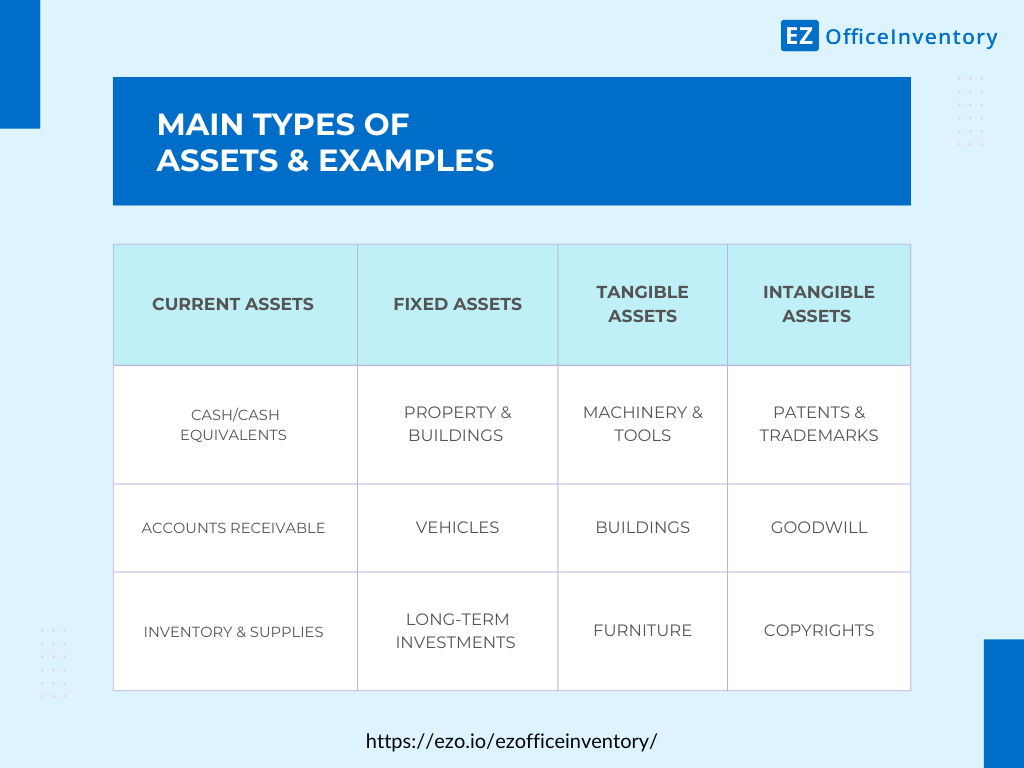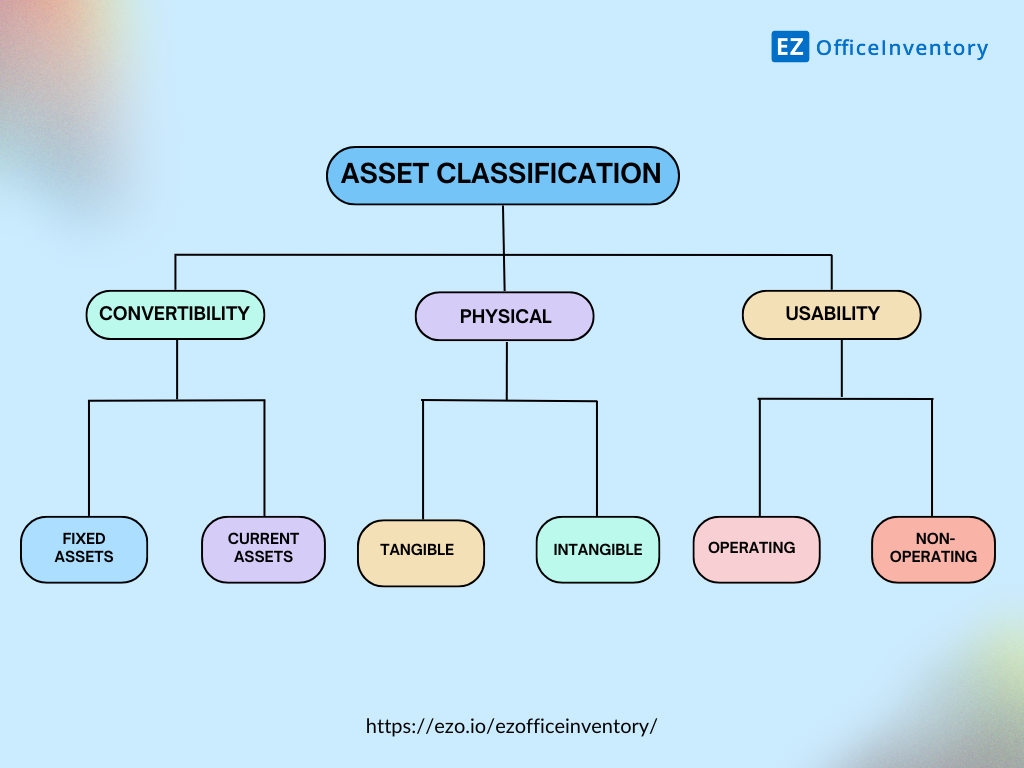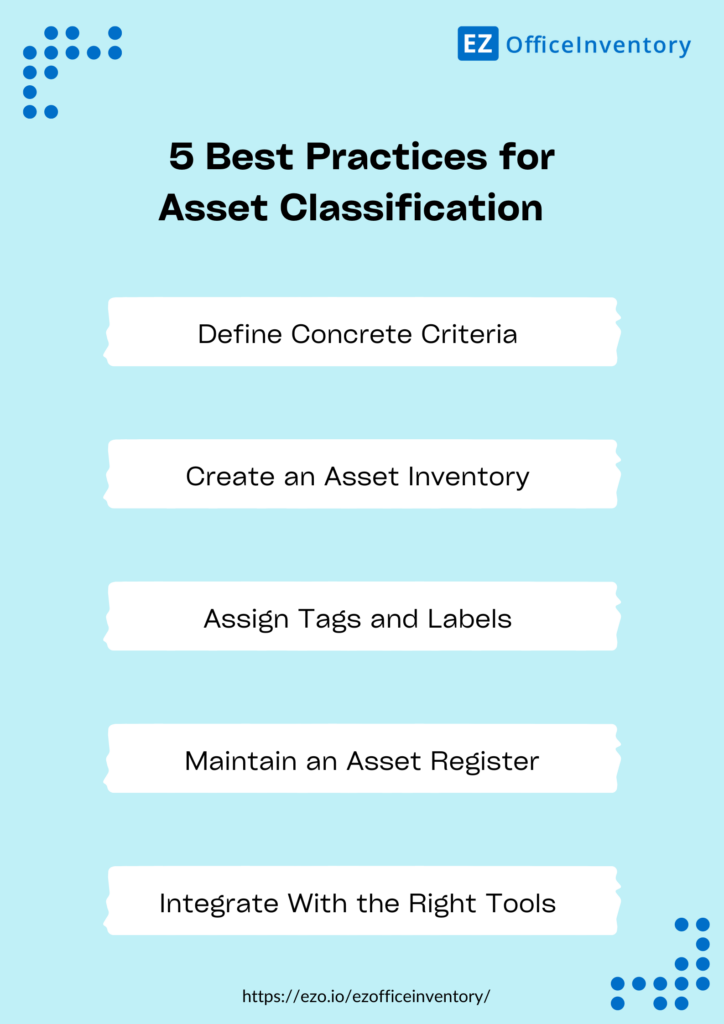Assets are resources owned by a business to generate revenue, and support operations. The right types of assets can enhance business efficiency by improving productivity and lowering downtime costs. In order to ensure that the correct type of assets are being used for a job, businesses can categorize items. Doing so enables businesses to streamline their asset management practices and optimize equipment use.
Without proper asset categorization, organizations are at the risk of experiencing inaccurate financial reporting and budgeting errors. To help you come up with a suitable strategy to categorize assets, this article will discuss the different types of assets, importance of classifications and step by step guide on how to classify assets.
What are the main types of assets?
A business can own various types of assets to carry out its daily operations. Organizing these assets according to their individual characteristics helps improve resource allocation for greater returns. Let’s briefly discuss the different types of assets a business is likely to own:
Current Assets
These assets can be converted into cash or are expected to be used within a year. Current assets include:
- Cash and Equivalents: Physical money, bank balance, and short term assets that can be converted to cash.
- Accounts receivable: Money owed by clients for the services delivered to them.
- Inventory and supplies: Consumables such as raw materials, textile and plastic.
Fixed Assets
Fixed assets can be classified as long-term assets that are expected to result in future income and are more profitable than current assets. Some examples include:
- Property, plant and equipment: Tangible assets such as buildings, machinery, vehicles and IT equipment.
- Long-term investments: Investments that are expected to bear returns after a year.
Tangible assets
Assets that have a visible, physical form are mainly called tangible assets. These assets form the foundation of business operations and include:
- Machinery: Tools and machinery used in the production process.
- Furniture and fixtures: Office infrastructure, fittings, tables and chairs.
Land: All property owned by the business.
Intangible Assets
Non-physical assets that add value to the business. Popular examples include:
- Intellectual property: Any information produced and owned by a business, such as copyrights, patents and trademarks.
- Goodwill: It is the value of your company brand, its customers, and associations.

How to classify your assets?
It is important to properly categorize your assets to maintain accurate financial records. Doing so can help you create lifecycle management policies to minimize wastage and derive maximum benefits. Here are some factors that can help you classify and strategically manage your assets:
Convertibility
Assess how quickly the assets can be converted into cash. All those that can be converted easily can be classified as current assets.
Functionality
Figure out whether the assets have an operational or non operational value in your business. Non operational assets include vacant land, short term investments, and idle equipment. Whereas operational assets can be categorized into inventory, assets for sale or investment property.
Usage Frequency
There are some assets that are used on a daily basis and are crucial for everyday tasks. These assets can be categorized as high-usage items. On the contrary, low-usage assets are items that are used less frequently and under specific conditions.
Value
Assets can be classified according to their potential value in the market. There are three main ways to calculate the value of your assets:
- Standard cost method: This gives the value at which the asset/s were purchased at
- Depreciation method: Calculated as subtracting depreciated cost from historical cost
- Market Value: The value of assets if the assets were to be sold at the current time
Legal requirements
Some industries may find it easier to classify different types of assets according to similar regulatory requirements. For instance, they can group together assets that follow the same compliance rules such as HIPPA, GDPR.
Why is it important to categorize assets?
Classifying assets into suitable categories simplifies asset monitoring, improves productivity and leads to efficient workflows. For instance, a large number of high-usage assets will act as an indication to have robust preventive maintenance strategies in place to ensure smooth operations. Here are some ways how asset categorization can be beneficial for firms:
Better asset management
Asset classification helps businesses implement management practices for optimal usage and allocation. For instance, high-usage assets need to be tracked continuously to ensure they are properly maintained to last their entire useful life. Moreover, asset categories help to identify which assets are critical for business functionality to facilitate timely equipment procurement.
Accurate financial reporting
Having suitable asset categories enables efficient compliance with regulatory requirements. All assets following GDPR compliance can be tracked at one place– making sure that the correct technique can be applied to all relevant groups of assets.
Other than this, tax can be accurately calculated when assets are divided into respective categories. For example, tangible assets need to be deprecated whereas intangible assets are amortized. All these details can be carefully catered to with the help of asset categories leading to reliable financial records.
Improved risk mitigation
Risk management can be streamlined once all assets with similar properties are grouped together under the same label. As an example, tangible assets tend to have very different risks as compared to intangible assets. Keeping this in mind, a business can define internal asset audits, non-disclosure agreements, and cyber security measures for all intangible assets owned. These strategies can then be evaluated and monitored to gauge their impact on performance and overall efficiency.
Increased operational efficiency
Distinct asset categories help businesses improve their performance through effective allocation and usage. An organization with multiple offices can categorize assets according to its locations. Doing so simplifies the inventory control processes by setting up procurement plans for each respective location. Other than this, with the correct valuation methods, businesses can timely dispose off or acquire new assets, making operations as smooth as possible without unexpected downtime.

5 Best practices for asset classification for your business
While there are some distinct asset categories by definition, businesses sometimes find it challenging to implement those categories. In order to overcome common obstacles in the classification process, businesses can deploy some key best practices. Let’s briefly discuss how firms can effectively set up their asset classification procedures:
Define a concrete criteria
There are numerous ways to categorize assets. Choose the one that best suits your business and follow through with it to maintain consistency across all departments and locations. For example, a manufacturing industry can classify assets into current/fixed, high/low value and operating or non-operating. Similarly for a multinational company it is important to incorporate locations into the classification procedure.
Create an asset inventory
To start the categorization process, you need to know what assets you have, where they are and who owns them. Keeping this in mind, it is important to create an inventory of all items owned by the business. To carry out the inventory process seamlessly, businesses can invest in an asset management system for accurate results. Such systems deploy the use of barcode scanners and can reduce the time taken to generate a record of all inventory items.
Assign tags and labels
Once the physical inventory is complete, the next step is to assign tags and labels to all items. Some common options for asset tagging include barcodes, QR codes and RFID. Select the mechanism best suited for your business. These tags work through a unique identification system assigned to each asset. The label can then be scanned and all asset information recorded in the asset management system.
Maintain an asset register
It is important to record critical asset details in order to successfully implement asset categories. This can be done by maintaining an asset register including information such as purchase dates, depreciation methods, maintenance events and costs. Doing so provides a baseline to strategically plan out categories for different types of assets.
Integrate with the right tools
The type of tools a business uses determine how easy it will be to implement asset categories. In order to enable a seamless process, it is important to adopt the right tool. For these tasks, businesses mostly opt for cloud-based asset management or inventory tracking software. These software offer built- in tagging capabilities to easily monitor and control asset movements and growth throughout their lifecycle. By automating inventory, depreciation and maintenance tracking for all assets, businesses can derive the maximum returns on their investment.
How to evaluate and upgrade your asset classification process?
An asset classification technique should be constantly monitored and revised to incorporate new equipment, compliance rules and maintenance needs. These easy steps will help upgrade your asset classification for better results :
Regular Audits
Organize quarterly or bi-annual internal audits to oversee the current asset categories. Create an inventory of how many new items have been purchased and assign them to suitable categories. Flag out any assets that have malfunctioned or no longer serve the intended purpose– remove them from the records and re-allocate their categories.
Standardized guidelines
Small business and large organizations both should have a standard operating procedure to ensure consistency and accountability across departments. This means that certain policies defined for a specific category should be followed through without any alterations. Such a practice can be easily implemented with the help of a centralized database that shares asset information across employees in real-time.
Monitor performance
After setting a strategy in place, make it a habit to regularly monitor and evaluate how assets are performing. Clearly defined categories make it easier to run reports and track critical KPIs related to assets. For fixed assets, the returns to investment can be closely observed to check whether they come up to the mark. A few common causes for low returns can be aged assets or broken down equipment. Exploring different options can help eliminate slow or lagged asset productivity.
Incorporate training
In order to derive the maximum return from business assets, employees should be properly trained on how to use, classify and manage assets according to their specific characteristics. This can be done by conducting regular training sessions to share information regarding any updated compliance rules, and usage policies. Assets being used in the right manner are expected to last longer and perform better.
Leverage Artificial Intelligence (AI)
Businesses can incorporate Artificial Intelligence (AI) into their asset categorization process to reduce time, save effort and automate repetitive tasks. AI can pick up on usage patterns within the organization and classify assets according to certain characteristics. Businesses using AI can even go beyond traditional classification and help organize assets based on their performance, and impact– maximizing returns to investment.

Different types of assets owned by top 3 industries
Different types of industries own a diverse range of assets, intended for specific economic returns. Depending on certain characteristics, industries can classify assets for easier management and tracking. Let’s take a look at a few common examples of asset own by 3 popular industries:
Healthcare Industry
Categorizing medical equipment involves grouping items based on their common characteristics such as usage, lifespan, and value. Asset classification in the healthcare industry helps technicians easily track inventory levels, maintain compliance, and schedule maintenance. Here are the common asset categories in healthcare institutions:
- Current assets → medical supplies, pharmaceuticals, and cash
- Fixed tangible assets → Diagnostic equipment, Hospital beds and furniture, buildings and facilities, and ambulances.
- Intangible assets → Patient records, healthcare software license, and medical research patents.
Education industry
Grouping education assets makes it easier to plan budgets and allocate funds for procurement, replacements and insurance management. Here are the main types of education assets:
- Current assets → Teaching supplies, accounts receivable and cash
- Fixed tangible assets → Buildings, classrooms, buses, computers and IT devices
- Intangible assets → Educational software license, curricular, school logos, accreditation certificates
Construction industry
Having a defined set of asset categories in the construction industry streamlines project management by providing detailed information on the available equipment in use. For instance, construction managers can accurately calculate depreciation, make a case for replacement and justify costs involved based on the returns expected. Here is a list of some common asset categories for construction:
- Current assets → Raw materials, work in progress inventory and cash
- Fixed tangible assets → Machinery, vehicles, buildings and tools
- Intangible assets → software license, patents and trademarks.
Gear assets towards Better performance
Businesses may find it difficult to track a diverse range of assets without a proper management system. With the right tools it becomes easier to classify assets according to their physical attributes, ability to convert to cash and usage. Following these classifications, businesses can mainly divide assets into fixed, current, tangible and intangible. These categories can be set as a starting point for policies for asset lifecycle management.











